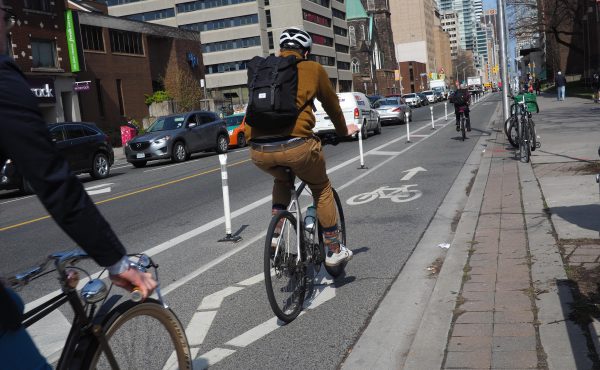
Every Tuesday, Todd Irvine of Local Enhancement and Appreciation of Forests (LEAF) will post a stop from the Toronto Tree Tours, a collaborative project of LEAF and the Toronto Public Space Committee. The Toronto Tree Tours offers walking tours in neighbourhoods across the city as well as virtual tours on its web site. The aim is to introduce Torontonians to the individual trees in their neighbourhood while telling stories of our city’s ecological and cultural history.
– – – – – – – – – – – – – – – – – – – – – – – –
Trinity Bellwoods and Neighbourhood: Stop 6
On the east side of the bowl, there is a grove of young trees — red oak (Quercus rubra), burr oak (Quercus macrocarpa), Kentucky coffee tree (Gymnocladus dioicus), sugar maple (Acer saccharum), hackberry (Celtis occidentalis) and freeman maple (Acer x freemanii) — that were planted in 2006 by Parks, Forestry and Recreation staff at the request of the Friends of Trinity Bellwoods. Because it is difficult for trees to reproduce in a maintained recreational park, they need to be planted manually. Unlike trees in a forest, trees in a park do not reseed themselves because the thick turf does not leave space for their seeds to germinate, and if by chance they do start growing, they are cut down by lawnmowers or trampled under foot. Ideally, new trees would be planted every decade as space becomes available to ensure a consistent healthy canopy.
Survival of newly planted trees in city parks is often precarious because, like most trees that grow in an urban environment, they initially require a significant amount of watering and care. These particular trees, however, have a much greater chance of survival because of the Adopt-a-Tree program initiated by the Green Space Committee of the Friends of Trinity Bellwoods. Local residents sign up to adopt a tree, and in doing so, agree to water it throughout the warm, dry summer months when drought is the main threat to a tree’s survival. This program gives people a sense of collective ownership over Toronto’s urban forest and enables park users to get to know one another while ensuring the health of neighbourhood trees. The program has been so well-received by community members that there is now a waiting list to adopt a tree.
Upcoming tours: Parkdale Neighbourhood
When: Wednesday August, 22 @ 7:00pm
Where: Masaryk-Cowan Community Recreation Centre
Photo by Liz Forsberg.


9 comments
Grange residents have adopted ALL of the trees in Grange Park and have implemented an informal schedule to water the trees. And now, the brown grass is starting to turn green.
Thanks for sharing Ceta. There are heartening examples of residents taking responsibility for trees all over the city. I would be interested in hearing others.
Todd–
There are a few trees down the street from me that were planted earlier this year outside a newly-built rental hi-rise. The trees aren’t doing too well–they’re mostly bare, and the few leaves that one tree sports are brown around the edges (due to water deprivation, I’m assuming).
I’m sure I should know this already from reading your other posts, but I can’t remember and the LEAF website doesn’t seem to deal with trees in public spaces: Is anyone responsible for watering these poor trees? Should I be asking the Starbucks a few feet away or the apartment building’s management to water the trees once in awhile? I’m assuming the trees need more than the few litres of water that I’d be able to carry over in a jug, but if not I could do that.
Melissa,
trees on public property are the responsibility of the City, but as we know the City does not have the resources to care for the trees they plant. Politics as they are, the push is on to plant as many trees as possible. The problem is that instead of “planting” trees we should be “growing” trees. This is not just semantics, planting a tree takes 1 day, growing a tree takes 100 years. If we are really committed to increasing our urban forest canopy cover we need to recognize that trees need care, especially water, and as climate change heats up our city their needs will increase.
The short answer is that the trees badly need water, the City is not doing it, so residents and business owners need to help out. Ideally, newly planted trees would get about a half hour of water from a slow running hose 2-3 times a week when it has not rained. Larger trees could use much more water, again by placing a slow running hose under its canopy and moving it around about every 1/2 hour.
Thanks! I’ll see what I can do…
Thank you for taking up the cause.
check out this link.maybe we should think twice about keeping tree planting in the city hall budget.take note joe pantalone
http://news.yahoo.com/s/livescience/20070812/sc_livescience/treeswontfixglobalwarming
For Todd Irvine,
Todd,
Your reputation suggests you can help an old oak in Uxbridge from being ravaged by officialdom. Are you a cerified Arborist? We have a $500 budget to get an Arborist to do an honest assessment very soon of an urban oak on Third St South. The report will be given to Uxbridge Council, a body that seems to have no policy on preserving trees beyond cutting down as many as possible because the Roads Department finds them inconvenient and ‘dangerous’. To learn more you might call James Foster (my son who lives on Third Avenue) at 905 852 7717.
David Foster of Port Perry
I am worried about a small urban forest that developers want to chop down at Sentinel and Finch, Fountainhead Rd.
Their arbourist call some of the trees “low quality” but many are healthy and over 1″in diameter. We are fighting it up here.